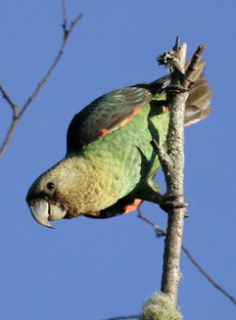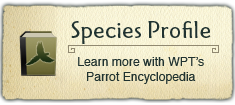Project Regions:
Cape Parrot |
|
|
Collaborators/Funders
Isdell Foundation, The Percy FitzPatrick Institute for African Ornithology (University of Cape Town), Birdlife South Africa, Cape Parrot Working Group (CPWG), Kurisa Moya Nature Lodge, University of Witswatersrand
Many threats put Cape Parrots at grave risk
The Cape Parrot (Poicephalus robustus) has undergone a population collapse over the last century as a result of forest loss, trade and disease.
Progress and outcomes: Beginning in the mid-1990s WPT has supported a number of projects to help save the Cape Parrot. Since then there has been work to restore habitat, assist wild breeding, and study disease risk. Local communities have become involved in caring for the critical Afromontane forests that are vital to the survival of the parrots.
Focus of future work: Since 2013 WPT has supported efforts to monitor Cape Parrot populations and spread awareness of the plight of these birds. Through systematic
surveys of key sites, the project aims to track population trends and understand the drivers of seasonal movements and the interplay between Capes and other species. Nesting sites have been identified and efforts are being expanded to study areas further afield. An outreach program has involved 100 school-age children in activities and games both inside and outside of the classroom. In 2020 an action plan entitled 'Cape Parrot and Mistbelt Forest Conservation Action Plan,' a collaborative effort between the WPT and eleven other organisations, was published and outlines in detail ecology, threats and steps needed to protect these birds and their wild spaces.
With your help, we can better understand the Cape Parrot and continue to work towards effective solutions to further their conservation.
World population: 1477 (2021)
Where found: Endemic to the Republic of South Africa, extending from the Amathole and Transkei regions to southern KwaZulu-Natal, and an isolated forest in the Limpopo Province.
History: Cape Parrots are recognized as globally Vulnerable by IUCN, having undergone a population collapse over the last 50 – 100 years. Their numbers are split equally between two separate populations in the Eastern Cape and KwaZulu-Natal, with an additional isolated group of approximately 30 parrots living in the Woodbush-Wolkberg forests, Limpopo Province. The main threats to these parrots include habitat loss and degradation and disease. Emerging threats include climate change which may cause habitat shifting and alteration, and the newly discovered polyphagous shot hole borer beetle, which is causing trees to die at a growing number of locations.
Threats:
- Habitat destruction
- Unsustainable trapping for the bird trade
- Slow reproductive rate
- Psittacine Beak and Feather Disease (PBFD)
- Persecution as a crop pest
Ecology: This species prefers high altitude Afromontane mistbelt mixed Podocarpus forest patches above 1,400m (4,200ft) and lowland/coastal forest during feeding forays. Birds feed on Podocarpus fruits, and on a variety of seeds from different tree species. They have also been recorded feeding on introduced food resources such as apples, plums, cherries, acorns, pine seeds, and Eucalyptus flowers. Birds roost communally in flocks of up to 10 parrots in large Eucalyptus or Podocarpus trees. The Cape Parrot travels vast distances (up to 100km) to preferred feeding sites, often staying for weeks to exploit this food resource. They are shy and easily disturbed when feeding.
Project Updates
- PsittaScene Vol. 29.1, Spring 2017
- PsittaScene Vol. 25.4, Nov. 2013
- PsittaScene Vol. 24.4, Nov. 2012
- PsittaScene Vol. 19.3, May 2007
- PsittaScene Vol. 18.3, Aug. 2006
- PsittaScene Vol. 14.4, Nov. 2002
- PsittaScene Vol. 14.1, Feb. 2002
- PsittaScene Vol. 13.1, Feb. 2001
- PsittaScene Vol. 11.3, Aug. 1999
- PsittaScene Vol. 10.3, Aug. 1998
- PsittaScene Vol. 10.2, May 1998
- PsittaScene Vol. 8.4, Nov. 1996
- PsittaScene Vol. 8.3, Aug. 1996
- PsittaScene Vol. 7.2, May 1995
- PsittaScene Vol. 6.4, Nov. 1994
- PsittaScene Vol. 5.3, Aug. 1993
WPT-sponsored research:
Diet of the Cape Parrot in Afromontane forests in KwaZulu-Natal, South Africa
Other publications:
Google scholar - Poicephalus robustus


































